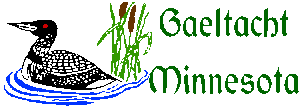
Quick Links
 |
Quick Links |
|
| GaelMinn Home | Dates: schedule, events | All Class | Tools | Amusements | ||
|
12/13/02 |
Newsletter |
Classes | Tools | Amusements |
For nearly two decades the volunteer teachers of Gaeltacht Minnesota have provided free Irish classes to the Twin Cities — and they aren’t showing any signs of slowing down! Denis Clarke of Co. Armagh founded the group in 1982, and today many of the nearly twenty regulars will tell you that it just wouldn’t be Monday night without a weekly dose of Irish.
Students often find their way to Gaeltacht Minnesota through their Irish heritage, or other aspects of Irish culture. As Ruth says, “I like a lot of traditional music and was not always able to translate the songs from Irish.” And Leah got started because her late husband wanted to renew the Irish he had learned as a child in Co. Clare.
Teachers came to Gaeltacht Minnesota as a way of maintaining their own Irish. Clarke studied engineering in Belfast and later worked for 3M, first in England and then in St. Paul. “I wanted to revise what Irish I had myself, what I had learned in Rannafast and in school,” said Clarke. After a fruitless search for teachers in Minnesota, he became a teacher of the language himself.
A year later, as Clarke taught a class at the Minnesota Irish Festival, he was unexpectedly greeted by a blast of fluent Irish from Frank Joyce, a native speaker from Glenamaddy, Co. Galway. Joyce succeeded Clarke as ardmhúinteoir (principal teacher) when the latter retired from the teaching task. And like Clarke, Joyce sought a way to preserve his own language.
“I didn’t want to lose contact with it. After all, it is my heritage,” he said. “And I started teaching it to others to try to give back to the people here what I had got back there in Ireland.”
Seán Kelly, New York-born son of Irish immigrants, then joined in to teach beginners. Kelly said that Clarke and Gaeltacht Minnesota were his first opportunity to study Irish.
“I was 46 years of age at the time but I felt I owed it to myself and my parents. My mother had taught me the prayers and some phrases but my father only used a few choice words. For years, I thought amadán was a term of endearment, so much did my father call me that,” Kelly said.
Gaeltacht Minnesota's history is linked with Father Lawrence Murray, of Co. Louth, who was ordained in St. Paul in 1910. After ordination he taught at the College of St. Thomas, spending summers in Ireland promoting Irish.
Murray founded his first Irish school in Co. Louth, but then transferred it to Rannafast, where Denis Clarke later studied. Murray and language supporters from Ulster created Comhaltas Uladh, founding An tUltach magazine—the longest running magazine in Irish—to serve this Gaeltacht.
Besides teaching Irish to hundreds, Gaeltacht Minnesota has raised over $8,000 for An tUltach's writing competition. One of the grateful winners, noted Donegal poet Cathal Ó Searcaigh, dedicated a volume of work to the 'Minnesota Gaels'.
Today, Gaeltacht Minnesota's continuous program allows people to jump in at any time, or even jump out temporarily. After six months to a year of dedicated attendance and homework, many students are ready for the next level. Some achieve a high level of ability, and a few have become teachers themselves —perhaps to play a role, one day, in bringing Gaeltacht Minnesota to new students for the next twenty years.
| 1910 | Father Lawrence Murray ordained at St. Thomas Seminary in St. Paul |
| 1920s | Murray founds Irish summer school in Co. Louth; founds An tUltach in Belfast; moves school to Rannafast, where Denis Clarke later studies |
| 1981 | Clarke founds Gaeltacht Minnesota in St. Paul |
| 1998 | Classes continue under Frank Joyce and Seán Kelly |
Comments and questions are welcome via e-mail